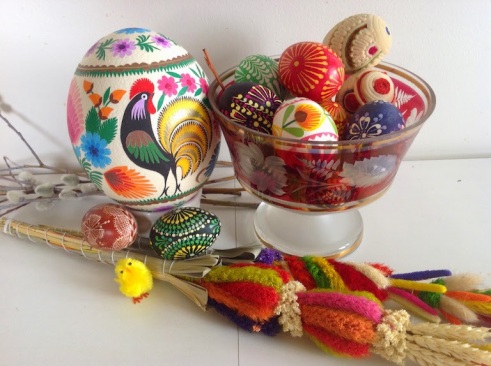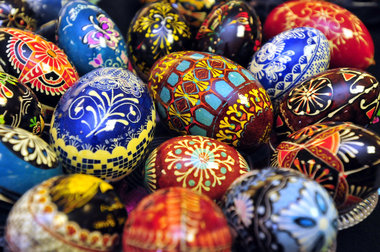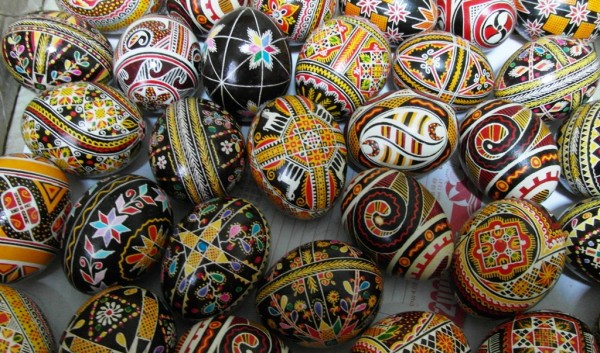Everyone loves chocolate eggs at Easter time, but for some cultures, eggs have always been much more significant than a sweet treat, and have evolved into a traditional art form in itself. This month, in Traditional Art From Around the World, I showcase some examples of Painted Easter Eggs from Eastern Europe.

Poland, The Czech Republic an d other Eastern European countries, follow a tradition of decorating eggs, in specific designs and colors, at Easter. The designs themselves are painted on hen or goose eggs, not wooden eggs, as some might think, and are executed with great care using age – old techniques. The egg yolk and white are either allowed to dry up over time, or are removed by blowing through a small hole in the egg.
The designs are highly indicative of not only a cultural region but, in some cases, also a particular family, as can be seen in the following photo, from http://polishfolkdolls.blogspot.com.au/

The practice of covering an egg,with knotted wire, first developed as a Slovak tradition, but is also used in egg creations in the Czech Republic. Motifs and color combinations can at times appear cross cultural, and while traditional styles prevail, egg artists add their own individual form of inspiration in order to personalize the decorated Easter eggs.

The most recognizable symbol of Easter, in Prague and the Czech Republic, is a hand-painted or decorated egg known as “Kraslice.” These eggs are made from ordinary eggs and ink, by the village girls, and are given to the village boys, on Easter Monday. On Easter Sunday, the boys make a kind of twisted cane/whip that usually decorated with a ribbon. On Easter Monday, they then travel to the houses, to visit the girls, and hit them around the legs with this whip, (an old tradition supposedly thought to increase fertility), after which the girls then give the boy an egg which the girls themselves, have decorated!
[Where were women’s rights in those days?]
These days the eggs are not so much a gift of love, from girl to boy, as a general reminder of the heritage and beauty from the region according to the differing techniques unique to each geographical, or cultural, area.

In Valassko, (Wallachia, Romania), Easter eggs are decorated in red, orange, and black with figural motifs like girls and roosters, whilst South Moravia is known for eggs created using the scratching technique.

Ukraine
Painted and decorated eggs is a traditional art form that dates back to ancient times in the Ukraine. As such, each regional area and indeed, each family developed rituals, symbols and meanings for Easter, along with their individual brand of decoration for the Easter Egg.
“Pysanka” is often taken to mean any type of decorated egg, but it specifically refers to an egg created by the written-wax batik method, utilizing traditional folk motifs and designs. In the western Ukrainian town of Kolomyya, there is a museum dedicated to ‘Pysanky’, with several thousand eggs on display.

The word pysanka comes from the verb pysaty, “to write”, as the designs are not painted, but ‘written’ with hot beeswax, using a stylus or a pin-head. Wooden and beaded eggs are also known as “pysanky,” because they mimic the decorative style of pysanky, but in a different medium.
[Source: Wikipedia]

Several other Ukrainian techniques of decorating eggs can be identified throughout the region. All but the krashanky and lystovky are meant to be decorative, (as opposed to being edible).
- Krashanky –from krasyty (красити), “to decorate”– are boiled eggs dyed a single color (with vegetable dyes), and are blessed and eaten at Easter.
- Pysanky –from pysaty (писати), “to write”– are raw eggs created with the wax-resist method (batik).
- Krapanky –from krapka (крапка), “a dot”– are raw eggs decorated using the wax-resist method, but with only dots as ornamentation (no symbols or other drawings). They are traditionally created by dripping molten wax from a beeswax candle onto an egg.
- Dryapanky –from dryapaty (дряпати), “to scratch”– are created by scratching the surface of a dyed egg to reveal the white shell below.
- Malyovanky –from malyuvaty (малювати), “to paint”– are created by painting a design with a brush using oil or water color paints. It is sometimes used to refer to coloring (e.g. with a marker) on an egg.
- Nakleyanky –from kleyaty (клеяти), “to glue on”– are created by glueing objects to the surface of an egg. Eg Lace
- Travlenky –from travlenya (травлення), “etching” – are created by waxing eggs and then etching away the unwaxed areas. This is not a traditional Ukraine practice, but has become popularized recently.
- Biserky –from biser (бісер), “beads”– are created by coating an egg with beeswax, and then embedding beads into the wax to create geometric designs.
- Lystovky –from lystya (листя), “leaves”– are created by dyeing an egg to which small leaves have been attached.
Other Eastern European countries also may use wax resist techniques to decorate their Easter eggs:
Belarusians (пісанка, pisanka)Bulgarians (писано яйце, pisano yaytse)Croats (pisanica)Hungarians (hímestojás)Lithuanians (margutis)Romanians (ouă vopsite, incondeiate or impistrite) Russians (расписанное яйцо “rаspisannoe yaitsо”)Serbs (pisanica)Slovaks (kraslica)Slovenes (pisanica,pirhi or remenke)Sorbs (jejka pisać). [Source: Wikipedia]
Marie Jukubickova (R) and Ludmila Vlasakova wearing traditional costume decorate Easter eggs in Vacenovice, South Moravia, Czech Republic. The women use the old method of scraping colored eggs with a nail file to decorate them and are the last two women in southern Moravia who know this method decorating Easter eggs for almost 70 years. [Source: http://forum.lovelimes.com/general-disc-f13/hand-painted-easter-eggs-t31235.html#.VSTRAuHE7Dc%5D
Traditions that are in danger of dying out.
Something to Ponder About.



Yeah, everywhere you go in the world, tradition is under threat, for sure. Works of art, the eggs.
LikeLike
Thank you, Boeta. Indeed it is. I hope by showcasing it, we can reach those who may be interested enough to keep these valuable traditions alive.
LikeLiked by 1 person
The eggs are so delicate and beautiful. It has to take a steady hand to paint or decorate eggs like this.
LikeLike
Yes, I thought about that. I watched a YouTube video on the painting process and the painter held the egg in her non painting hand all the while she painted.
LikeLike
My husband’s family keeps the polish traditions and while my Granddaughter and I were shopping at the local Polish market she asked for and picked out her own painted egg. Dziadzi’s (my Husband her Grandpa) heart melted when he heard she opted for the painted egg over a chocolate egg. He was even more pleased when our daughter in law had to take a minute to tell us how beautiful it was. Some traditions just need to carry on through out time.
LikeLike
What a lovely story and I’m so pleased that there are younger generations who still appreciate the old art forms. It is so important to keep traditions alive otherwise they fade into forgotten history and cannot be easily resurrected. Then it is almost like we lose an important part of our psyche and identity. Are the Polish markets always held at Easter?
LikeLike
The markets are year round. I use them as much as possible for kielbasa and home made piergieos
LikeLike
Sounds delicious1
LikeLike
In Japan a great art is done by painting the insides of sea shells in the finest detail..
LikeLike
That sounds very interesting, Gerard. And a great topic for Traditional Art next month. Do you know if it has a particular name? If you have enough information, I would love it if you would write a guest post on the topic?
LikeLike
Such beautiful artwork! It’s a sad thing that such wonderful traditions are dying out. The painted eggs reflect such skill in the artist involved. I’d coose one of those instead of a chocolate one, any day. I’ve never seen one covered in knotted wire, but it sounds fascinating.
LikeLiked by 1 person
coose?
LikeLike
All so delicately painted – great post with much interesting information, Amanda.
LikeLiked by 1 person
Takk saa mycket!!
LikeLiked by 1 person
Beautiful
LikeLiked by 1 person